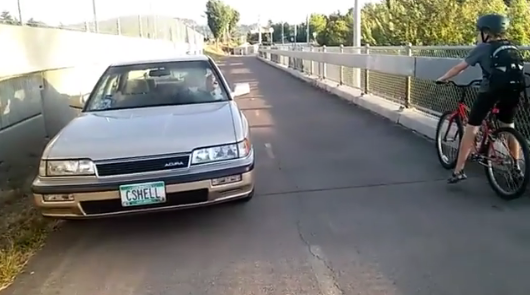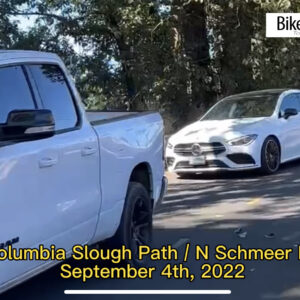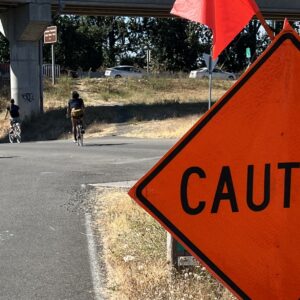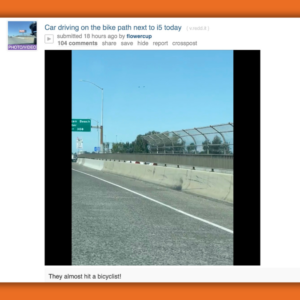
In 2013 someone managed to get their car partway across the Columbia River on the I-205 multi-use path. Now it has happened again.
Three years ago a woman drove until the path narrowed so much that her car got sandwiched between the path barriers. This time the person driving the car realized her mistake (partly due to bicycle riders who had stopped to talk to her) and didn’t get very far. The driver looked flummoxed and seemed to have just made an innocent mistake.
https://www.instagram.com/p/BJb9Gf_hD19/
Local resident Spencer Hubble was apparently riding the 205 multi-use path when he came upon the car. It appears she entered the path by turning left onto the path at this location. Hubble was clearly amused to see her there.
Advertisement
What strikes me is something I’ve noticed a lot lately- overly lax infrastructure that allows a large amount of dangerous activity. This is part of the reason I’m a fan of grade-separated bike infrastructure, even if it’s just a few inches of curb next to a cycle path.
While it wouldn’t stop every driver, it’d certainly be more difficult to argue “I didn’t know” if there was a bollard or a curb in the way. Then again, at some point people who operate vehicles — especially large ones with powerful engines and made out of steel — need to learn how to use them responsibly.
Journalist Lizzy Acker reached out to police and didn’t receive a response. In the 2013 event the driver wasn’t even cited.
– Ted Timmons, @tedder42
Our work is supported by subscribers. Please become one today. You can also make a one-time donation here.






Thanks for reading.
BikePortland has served this community with independent community journalism since 2005. We rely on subscriptions from readers like you to survive. Your financial support is vital in keeping this valuable resource alive and well.
Please subscribe today to strengthen and expand our work.
The crazy thing here is that if she had kept driving, should could have gone all the way to Division and re-entered the roadway. They clearly need to do a bit more at the Powell and Division MAX stations to prevent this.
Yep. I’ve gotta say, there’s a pretty strong hint you aren’t turning onto a road in that Streetview. But these are the “innocent mistakes” that are forgiven even when injury or death is involved.
They want it all, a tiny bit of the infrastructure gets carved out for the sole use of bikes and pedestrians and the world of happy motoring can’t handle it. Maybe it is just a subconscious impulse by someone who doesn’t belong on the road any more, but the cars want it all.
You suggest she drove on the path intentionally?
“Innocent mistake” is interesting terminology.
What is the threshold for being guilty of willful incompetence?
How little attention does someone have to be paying to make such a blunder while operating a machine that is easily capable of causing substantial destruction?
Genuinely curious.
Incompetence, sure. But “willful”?
Not sure if that is the correct word but… you know, negligent? Isn’t that the technical term for willful incompetence?
That’s what I’m curious about. Not in a snarky way! 😉
I guess with the presumption that anyone who is actually incapable of competence would not qualify for a motor vehicle permit in the first place. (could very well be an unlicensed driver)
But is an adult who is not *unable* to become competent due to a mental impairment or other circumstance not essentially unwilling to become competent?
Same would go for someone locking a child or animal in a hot car, et cetera. Both the court system and society have pretty strict policies that ‘stupid is no excuse’ for reckless endangerment.
This is not just semantics. I have been genuinely curious about this sort of thing. Not interested in crucifying this individual driver, but this particular instance seems kind of like a case study…
It is hard to fathom mistaking that bike path for a street if you are awake/attentive… it is pretty clearly a sidewalk/plaza, and perpendicular to the auto lane. Someone who doesn’t recognize that is probably never going to recognize a sidewalk or crosswalk in any context.
And we’re talking about being able to not accidentally drive a metal box with the equivalent force of 150+ horses down a bicycle/pedestrian path with people on it.
While very consequential, driving a motor vehicle is literally not rocket science. It is pretty easy.
Clearly the “mistake” was unintentional and thankfully no one was hurt, but at what point is the incompetence facilitating the accident “innocent” from someone who has no medical grounds for lacking competence?
Thankfully no one was hurt, but I don’t know how much closer to killing someone a “mistake” has to get before being considered a pretty serious issue.
>>> negligent… Isn’t that the technical term for willful incompetence? <<<
No, it isn't. Negligence is carelessness; incompetence is inability.
Are you looking for “reckless”?
Someone who thinks that sidewalk in front of the path entrance looks like a road probably should not be driving. However, a bollard would easily stop this.
My thought exactly. Why don’t these entrance points have bollards? Seems like a very standard treatment for a scenario like this.
An essential part of engineering is imagining what could go wrong, and designing to protect against each possible failure mode. We also multiply by 2 for most things involving safety, with additional factors for likelyhood, importance, or severity — then find an acceptable solution which fits the budget. Many of the considerations come from observing past failures.
Perhaps designing transportation infrastructure should be like engineering?
It also helps if designers actually use the product.
Engineers already do this for roads, and it ends up creating wider roads with less sharp curves that encourage speeding.
To be fair, I’ve come close to hitting bollards in the daytime as well. Maybe I’m a spaz, but I think they cause more problems than they solve.
Really>? I think they are absolutely essential to keeping cars out of where they shouldn’t be.
If you cannot navigate a bollard… well, there are zilch engineering standards for their use; engineers love placing them on narrow pinch points and sharp curves which make them 10 times more dangerous than they should be.
It’s just that I generally don’t expect a metal pole to be sticking up in the middle of a bike path.
Maybe I should be more open to new experiences.
Then learn to expect them.
No, I think I’d just rather hit them, thank you very much.
Suit yourself.
That works fine only for access-controlled, divided highways. The goal in that situation is to protect the occupants of vehicles and move the vehicles quickly. Yes, that involves a trade-off between safety and speed and this requires some of the safety to be engineered into the vehicles. So, protecting everyone else from the highway means keeping them away from it. Applying a hammer to a nail is actually a good engineering solution to the problem of driving a nail. Maybe there’s some vestige of the “engineer’s hammer” in transportation due to the locomotive origin of the term.
Designing for the wrong use-case or ignoring failure modes is not good engineering. We don’t double the width of a handrail gap as a “safety buffer”.
About 1/3 of cyclist injuries (aprox. 166,000 a year) are from falls and collisions caused by road conditions- be it tracks, cracks, curbs, potholes, parked cars, or even bollards.
This is why the *bollard* needs to wear a bright green foam hat.
I dislike bollards on bike trails because they are not lit, and I think they present a danger to cyclists in low visibility situations.
bollards are obstacles in the center of the path that can be difficult to see…
In this situation, one high-viz vest and a helmet can protect thousands of cyclists.
Cover the bollard with reflectors, just as is done for traffic islands.
At what point does the bollard become more dangerous than the once in a blue moon driver? There is a bollard on a path in my neighborhood that is poorly lit and was painted black when it was originally installed. I was a lot more worried about someone hitting it while biking at night than about a car driving through the park. I was able to get the city to repaint it yellow, but it is still right in the center of where you would be biking and if you weren’t expecting it you could really hurt yourself if you hit it.
I’m also not a big fan of bollards, especially when they are placed at a conflict zone. I don’t want to be dealing with an obstacle at the same time I’m trying to accurately assess the dangers of several poorly guided missiles.
You say that, but drivers have almost taken out the bollard blocking entry to the MUP near the OMSI transit station on SE Caruthers(?)
And what do you think stopped them from driving onto the path?
Newsflash – No one came even close to getting injured or dying and the sky isn’t falling.
But like any close call on the roads it is a warning that something needs to be fixed. Lets care of it before there is death or injury, that is the real message of the tragedy on Hawthorne. We can’t wait till the next impaired driver mows down a bunch of school kids on a bike path. Put up the bollards ( removeable for sweepers), crank up the retests and get the impaired drivers off the road.
“Nobody died” is an incredibly low bar to set. Let’s fix things before someone gets hurt, not after.
Too bad responding to a death instead of preventing it has been standard operating procedure in this city for years.
You’re lucky if they respond to the death with anything stronger than words.
That was not a close call. It is not even news. She did not endanger anyone.
On the one hand, you’re right. On the other hand, that doesn’t really making it OK, just like driving my car on the sidewalk isn’t OK just because I’m going slowly and didn’t hit anyone.
You’re both right!
I don’t think bollards should be a standard feature of MUP entrances. They can be a hazard to cyclists especially those with long bikes, tandem, trailers and trailer bikes. I’ve never hit one, but I’ve seen lots of people come close and there are plenty of scars on existing bollards that seem to indicate some cyclists have it them.
“Easily removable bollards” are a bit of a misnomer, too. I saw the occupants of a City of Portland pickup struggling with the bollard on the Springwater Corridor at its intersection with SE Spokane Street. They had driven the length of the path from somewhere to the north and couldn’t get the key in the lock or the post out of the sleeve. The truck was blocking the path at a narrow point. I don’t know if they succeeded in getting the bollard out or whether they had to back all the way to a turnaround.
Even the Dutch have bollards. Yes, they do create some hazards for cyclists, but they also keep cars out, which are a much higher hazard. The benefits outweigh the costs.
I think the hazards presented by this car (and all others we know of on the trail) were much lower than would be presented by an unlit bollard.
Why does it have to be unlit?
Good point. Illuminated bollards on every trail! They’d be super useful for wayfinding at night.
A solar cell, a battery, and a few dim LEDs would be enough.
This person needs to have their driving PRIVILEGE revoked for some amount of time. They are either impaired by intoxicants or lacking the intelligence or common sense to drive a 3000 lb vehicle.
Well, you know what they say, C SHELL considered harmful.
Really, though, when someone is on a trail by mistake and trying to find a way out, whatever you might think about whether they should be there or not, they deserve some sympathy and a little help. Unfortunately, between being hardened to all the jerks that intentionally park in bike lanes and being completely useless at giving driving directions, I’ve never been all that helpful to anyone I’ve encountered in this situation.
More evident “Bikes & Peds Only” signs would help. In Holland, the Dutch use brick red pavement on their bike lanes / trails. Doing that at each entrance to the trail would set it off from something intended for automotive traffic.
Nice looking Acura, where I grew up they all rusted to death around 2004.
looks like it simply needs a “no motor vehicles” sign where she entered the path… lots of paths around here need such a sign…
Agree, I looked the street view map and am surprised there is no signage at the MUP trailhead at all.
A couple blocks from there, I also see a weird ramp that looks like a MUP to nowhere from SE Ellsworth Rd and SE 23rd that goes down to HWY 14. I don’t know what its purpose is(so a rider can connect to eastbound HWY 14?), but interestingly enough, it has both signage for NO MOTOR VEHICLES and has three bollards installed.
So let’s see, at the spot she entered there is 1. Pedestrian crossing stripes aligned with the path, indicating where people walk/bike through 2. yellow textured pedestrian crossing plates in the path indicating same. 3. Sidewalk type concrete block paving 4. public pedestrian plaza w/ stairs leading into the path 3. bike lockers adjacent to path 5. lane striping FAR to narrow to fit the width of a car. and NONE of this clued her in? In broad daylight? But the BIKEWAY signage to Division street was her excuse for choosing this route? Sound to me like an older/elderly driver looking for the quietest way because they are unsure of their own ability to drive on major streets or the freeway.
She is a menace on the road and deserves the same type of temporary hold/prohibition on her license as someone who had a medical emergency like a seizure would get. And not get it back until she received a statement from a doctor/dmv that she doesn’t have dementia and understands the rules of the road.
They the video on TV the other night of this driver’s immediate response when confronted about this. Basically her defense was that she drove on the path because there was a sign pointing the way to Division street.
Apparently it did not occur to her that there might be wayfinding signs on bike paths too. Despite the ridiculous shortage of wayfinding signs on MUPs generally, the presence of any sign on a crappy freeway-adjacent path is more amenity than drivers expect us to have.
Gotta love the unquestioned assumption that “a thing is paved and there is no physical barrier therefore i’m allowed to drive on it.”
An assumption that is excused for drivers but never for cyclists and pedestrians, who are expected to “know better” even if they are a teen or child.
I got onto the bike path around the lake in Madison, WI, once upon a time. It can happen to almost anyone, esp if that person does not ride bike paths, is unfamiliar with the exact interchange, is trying to monitor traffic, is near a freeway or other area that uses ramps and drift lanes, and there is inadequate signage. The driver was driving slowly and cautiously, and even stopped when bikes were near. At least she wasn’t drunk and or beligerrant, driving a massively oversized truck, windows rolled up. Nor was she the mo-ped driving fool driving in the dark on the 205 path with zero lights on a dark night and overoaded with eight leaf bags of cans strapped on @ 25-30 mph that almost killed me one night. I am sure maintenance vehicles travel that path periodically as well.
A flexible day-glo plastic bollard might keep the next car off, without hindering bicycle riders too much
It’s obvious the infrastructure was at fault for this person’s poor decision making.
All would be forgiven if the County staff just “paid for parking” on the bridge and put a box (or bucket) of Voodoo donuts …or iced Old Germans on the car hood. To take a page out of Timo’s classic handbook.
Ok yeah, that’s what I’m asking. Thank you, probably better terms.
The logic is that if it is a licensed driver and they have proven ability/competence. The default state is being licensed to drive. The default state is competence. That has to be the assumption, right?
Excluding a sudden change in circumstance (perhaps a stroke or seizure) can a person suddenly become incompetent, unwillingly?
Carelessness is also something I equate with willful incompetence.
Not sure if that logic is completely flawed or if you’re taking umbrage with the term or the concept, but I’m still curious as to what is the threshold for being guilty of willful incompetence?
Not paying attention, texting, being drunk… are those passive things? Or is it willful incompetence? …. actually I think the technical term might be willful neglect! 😉
Again not roasting this particular person but curious about the concept and seems there are a lot of folks who know the law/code for that sort of stuff. Thanks for the discussion!
At least everyone seemed polite in this exchange.
To those who say “Why worry? No harm was done?” imagine how much harm would have been done if the driver was a testosterone poisoned, coal-rollin`, ragin` young male pickup truck driver?
This incident turned out well because the automobile driver was willing to admit error and was polite.
This is VERY atypical behavior for American drivers. It is improbably lucky that this turned out as well as it did.
Refreshing to see someone admit they’re wrong without getting defensive. Well handled by both parties.